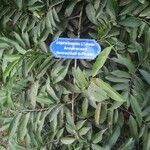A climbing evergreen shrub. It can grow to 5 m long. The leaves are oval to sword shaped. They are rubbery and glossy. They are 13 cm long and in opposite ranks. The flowers are creamy yellow. They occur singly or in pairs. One of the pair is modified into a hook which helps the plant to climb. The flowers have a sweet banana-like smell. The fruit is in grape like clusters.
Is a tall woody climber which is cultivated in Nairobi (Kenya, Nairobi Arboretum, 10 Mar. 1952, Greenway 8719 !). In Nairobi it forms a shrub about 2–5 m. tall.. According to R. O. Williams (U.O.P.Z.: 131 (1949)) a few plants are in cultivation in Zanzibar.







